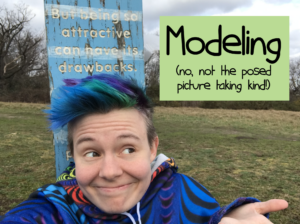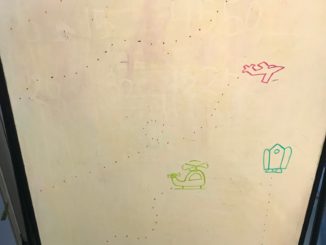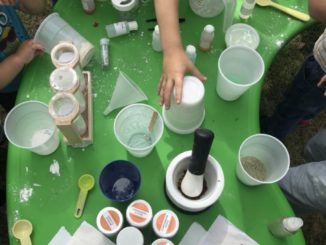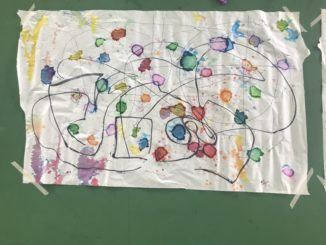Somebody asked me the other day if I’ve ever written a post defining what modeling is. I haven’t, but it’s a good idea since I suggest modeling things for children basically constantly. 🙂
I think I probably picked up the language from time in the AAC (augmented/alternative communication) community, because there’s a growing push and realization that parents, teachers, therapists, and caregivers need to model using a child’s AAC, or the same type of communication, in front of them for the child to also learn how to use that AAC. A baby who grows up and learns to speak using vocal speech will watch adults speak in front of them, hear adults speak to them, study the shapes lips make as they speak up close, hear a zillion varieties of sounds, try out a zillion varieties of babbling coming from their own body, etc before we ever expect them to speak a word.
It’s the same for AAC use. If a child has never seen anyone else hand anyone else a picture card to communicate, and never heard an adult tap on a tablet to tell something to a different adult, and never seen anyone speak by signing with their hands, then they have no idea that those things are forms of communication. They might be being handed them, coached or trained in them, but they’re not seeing it in the environment around them. If someone is trying to train you to do something you’ve never seen examples of, you don’t grasp how or why it’s meaningful. You just do it because you have to, because people more powerful than you are forcing it upon you, but that’s not the way to connect with something as meaningful, as rich and powerful as speech and communication.
This is where I picked up the concept of modeling from, and then I have taken it and applied it in a million other ways. (P.S., I don’t mean to imply that I’ve *invented* these usages because I super haven’t. I’m sure I’m copying a bunch of other people too! I just know that these days my theory, and therefore my writing, is littered with the modeling idea.)
Modeling writing to children. Do children see their adults write? If they do (some don’t, ever!) then what do they see them write *for*? Is it for fun, joy, delight? Is it a big horrible hassle that the adults hate? Is it utterly forgettable or their written words usually ignored — like getting hyped, writing a meal list on a whiteboard in your house and then forgetting to change it ever again? Is it always private, writing poetry or fiction for fun but only when the kids aren’t around? If children never see writing modeled for them as meaningful, then they will not believe writing is meaningful. They will believe someone more powerful than them forces it upon them and that’s the only reason to comply (maybe).
Modeling manners or pleasantries to children. If children hear their adults regularly use kind words and mannerisms, both to people out in the world and to them, they’ll pick up on how to use those social tags when they’re regulated and doing well. Anecdotally, I’ve never once told my kids to say sorry, please, thank you, excuse me, etc, and they do all the time. They were some of the first scripts they picked up because they heard me saying it to them all the time!
(As an aside that’s tangentially related: The closest I ever get is that if my child asks for something in a demanding way, or in a way that their voice implies they expect it to have to be a fight or they expect me to say no or not to help them, I’ll react to that the same way I would if anyone did — I’ll say something like “hey I’m happy to help you! You can just tell me,” or “you can just ask” (while I’m already helping them, not withholding help as the tone police). It’s more like, “oh I’m surprised this felt like a fight to you! I’m happy to help you out, remember? I’m on your team 😊” One of my kids usually doesn’t say anything to this and the other kid usually repeats themselves but with softer words/tone. I’m truly just trying to remind them…I’m always on your side, no matter what other adults in your life might be like.)
Modeling use of a toy or equipment is something I only do sometimes in specific circumstances, because I’m often happy and strongly prefer to let children explore things by themselves and play however they like, but sometimes in specific circumstances I might sit down beside a kid and begin playing with my thing while they play with their thing. It’s amazing what they can pick up on from parallel play.
I could go on and on, but you get the picture. The other key part of it is in the full phrase “modeling without expectation”. This can’t be some kind of short-cut or “hack” that you do to try to trick a kid into doing something you want. Kids sense that stuff a mile away. When you’re modeling without expectation, you’re showing them because the thing itself is desirable, important, whatever. You model manners because you, an adult, wish to use manners — not because you want to “trick” your kid into using them. You model writing because writing actually can be an inherently joy-producing human pursuit — not because you hope it’s a “hack” to make your kid write more.
So when somebody asks me, “Wait, do you mean that you don’t teach kids to ____?!” and I say that I *am* teaching them, I’m just teaching them entirely or primarily through modeling…this is what I’m talking about. Sometimes there’s good reason to overtly speak about what I’m doing, to explain it to the child or explain what I or the world want from them. But a surprising amount of the time, if I just show them the way to do something that I think is meaningful, powerful, or delightful, then they’ll instinctually want to join in.

[Image description:
A picture with the title “Modeling: (no, not the posed picture taking kind!)”
The picture that goes with the title is intended to be humorous, a play on words since “modeling” in English can also mean when celebrities or models pose for their pictures to be taken, to advertise a product, or to show fashion, things like that.
The picture is of me in front of a sign. The sign is an informational sign about butterflies and gives facts about them, but I am blocking all of the sign with my body except for one sentence. The only sentence visible reads, “But being so attractive can have its drawbacks.” I’m posing with a smirk like “eh, what can you do?” as if implying that I, too, understand the great burden of being “so attractive”. I have blue, green, and purple fluffy short hair combed up and swooped to the side, and a psychedelic rainbow hoodie. End description.]



